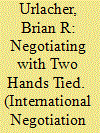| Srl | Item |
| 1 |
ID:
178371


|
|
|
|
|
| Summary/Abstract |
Ceasefires are part of most contemporary peace processes, however empirical insight suggests that the characteristics of ceasefires vary greatly across conflict settings. This paper contributes to filling a research and knowledge gap about how different types of ceasefire come about through a comparative case study of ceasefires in the Moro and communist insurgencies in the Philippines. I argue that to understand differences in the characteristics of the ceasefires in these conflicts, it is important to consider the aims, ideologies and strategies of the conflicting parties and how this shapes their approach to a ceasefire. Following this, I suggest that ceasefires must be analyzed and understood with sensitivity to conflict issues and approaches to violence, as this contributes to an explanation of how ceasefire is used as a political tool and how it shapes the dynamics of conflict. Based on interviews and document studies, the article maps the characteristics of ceasefires in both cases over time and analyses the approaches to ceasefires of the parties to the conflict. Knowledge of how ceasefires come about and what shapes them can help both academia and policymakers draw more informed and accurate conclusions about their outcomes and effects.
|
|
|
|
|
|
|
|
|
|
|
|
|
|
|
|
| 2 |
ID:
114741


|
|
|
|
|
| Publication |
2012.
|
| Summary/Abstract |
The Organisation of the Islamic Conference (OIC) has been involved in conflict resolution of a highly complex and intractable civil war in the context of Mindanao in the Philippines for over a period of 35 years. This article presents an investigation of such a long-lasting and arduous response by first, presenting an overview of the OIC in terms of its mandate, structure and previous conflict resolution activities. Second, it contextualises the Mindanao conflict by focussing on its main actors; and third, the OIC's response as a third party through different types of conflict resolutions modalities in the historicity of the peace process will be explored in the analysis section. The conclusions will summarise a set of reasons why the OIC's response has overall been ad hoc, politically charged and ineffective in bringing about a peaceful resolution to the Mindanao conflict.
|
|
|
|
|
|
|
|
|
|
|
|
|
|
|
|
| 3 |
ID:
149040


|
|
|
|
|
| Summary/Abstract |
In its 2003 Official Development Assistance Charter (ODA Charter), the Japanese government made peace-building one of its areas of focus. Since then, the government and Japan International Cooperation Agency (JICA) have been active in organizing and implementing peace-building support projects in the Middle East, Africa, and Asia. One of the government’s initiatives is a peacebuilding project in Mindanao, the Philippines, an effort that represents a break from the traditional mold: the development support efforts started contributing to the peace process before the signing of any peace agreement took place.
|
|
|
|
|
|
|
|
|
|
|
|
|
|
|
|
| 4 |
ID:
167453


|
|
|
|
|
| Summary/Abstract |
Theories of conflict resolution often posit unified actors as a simplifying assumption. In practice conflict actors often struggle to balance competing factions and centers of power. Schelling and Putnam have argued that factors that constrain what a negotiator can accept are a potential source of leverage in a bargaining process, yet a counter argument suggests that leaders seeking to negotiate, while facing divided government, may be less able to credibly signal their intentions. Drawing on event data from nearly 3,000 conflict-months, this paper analyzes the frequency of concessions offered by both rebels and governments. This study finds evidence that a fractured decision-process results in both rebels and governments making more concessions. Further corroboration is provided through a case study of the Philippine government’s efforts to negotiate an end to the conflict in the Mindanao region.
|
|
|
|
|
|
|
|
|
|
|
|
|
|
|
|